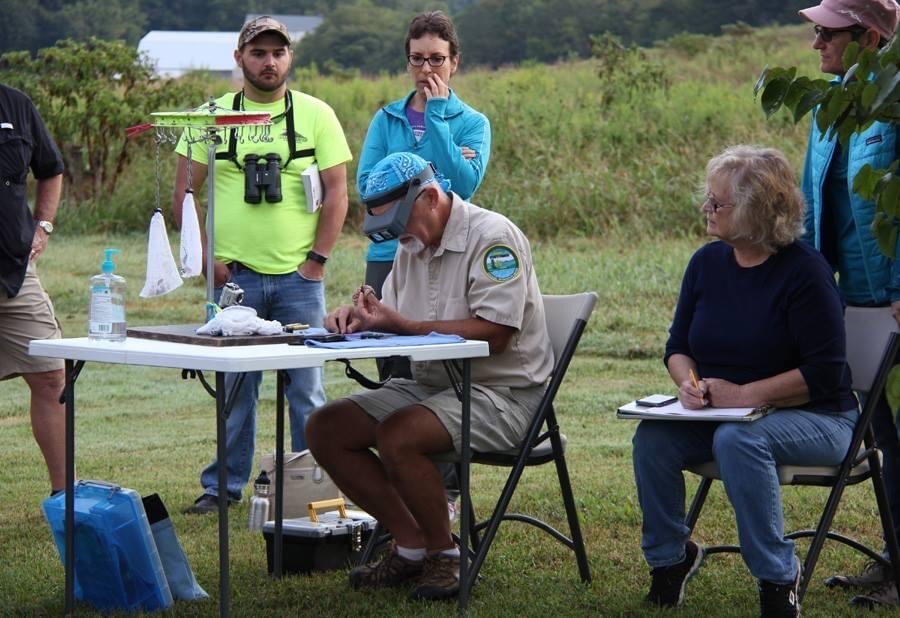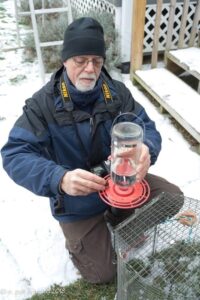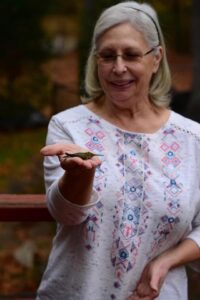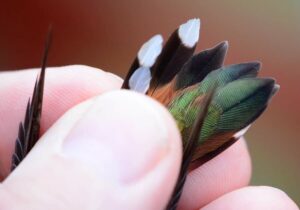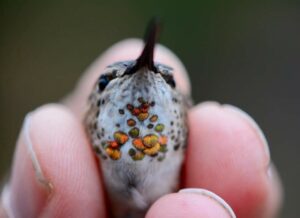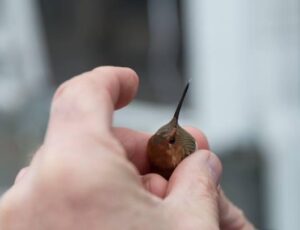Back in 2017, Clinton resident Pat Howard was performing a routine fall clean-up task, putting away his hummingbird feeders for the winter. Until he got “buzzed” by a hummingbird.
That there was a hummingbird still hanging around after it long should have headed off to Mexico or Central America for the winter was surprise enough. But this was not the ruby throated variety common to eastern North America. He posted photos to a local birding group on Facebook and got confirmation that he indeed had a rufous hummingbird at his house. The feeders stayed out.

“Rufus” in the hand of Mark Armstrong. (Photo courtesy of Pat Howard)
It’s now 2022, and “Rufus” is still wintering at Howard’s place on the Clinch River. How does he know it’s the same bird? Because he did what any smart, amateur birder/naturalist does. He listened to the people who told him to contact Mark Armstrong to come out and band the bird.
One of the first things Armstrong will tell you is “oh, I’d love to talk with you about hummingbirds.”
While he cannot say exactly why these rufous hummingbirds are so far off course, he can say that, while not a common visitor, he is getting more reports of them as well as more reports of overwintering rubies. The warm season range of the rufous is from northern California through the Pacific Northwest and western Canada up to Alaska. They should be wintering in Southern California, Arizona, Nevada and into Mexico.
Armstrong retired from his long-held position as bird curator at Zoo Knoxville in 2015. The New Jersey native started working there in 1979. His path to Certified Master Bird Bander started in a fairly normal fashion.
“To become a bander, you have to work with somebody who is a certified bander, kind of like an apprentice,” he said. “I took a class just to get my feet wet.”
He started out working with the late Bob Sargent, who, with his wife Martha, ran a banding station at Fort Morgan State Historic Site in Alabama for more than 30 years.

Mark Armstrong admiring his favorite subject. (Photo courtesy of Vickie Henderson)
“I basically became a member of his crew. He was training folks all over the Southeast,” Armstrong said. “But one thing he required everybody to learn was to band hummingbirds.”
Apparently, some banders are not big fans of working with the tiny birds, which are weighed in grams (average weight of a ruby is 3 grams, so not even one ounce).
“It does require extra knowledge, extra work,” Armstrong said. “You have to make your own bands, for one thing. But from my perspective, a chickadee is much harder to band. They’re very feisty. With hummingbirds, once you get them on their back in that little footy, by and large, they’re nice and quiet.”
Retirement has allowed Armstrong to devote more time to banding, including on his own 5-acre backyard in Seymour. He regularly participates in general banding events at Seven Islands State Birding Park as well as at Ijams Nature Center, including during the latter’s annual Hummingbird Festival.
For anyone thinking they’d like to start banding, Armstrong says “do not try this at home. You have to have a federal banding permit, so go learn from the pros.”
He also said while it doesn’t hurt to leave a feeder out for the hummingbirds (rufous or ruby) over winter, don’t expect an influx of birds. And don’t forget to clean the feeder and change the nectar regularly (skip the red dye). For the rest of the year, in addition to providing feeders, garden with the plants they need and lay off the pesticides.
“It’s the unpopular tip, but it’s the truth,” Armstrong said. “As with most other birds, hummingbirds eat lots of bugs, especially tiny ones, and they can’t get those from a poisoned yard.”
Go here to learn more about attracting hummingbirds to your yard.
Enjoy these photos from Armstrong’s banding adventures:
Beth Kinnane is the community news editor for KnoxTNToday.com.

